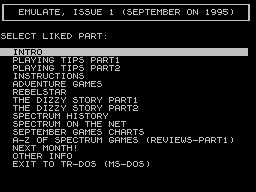|
#01
31 августа 1995 |
|
Part 7 - Spectrum history.

********************************
* PART 7 - SPECTRUM HISTORY *
********************************
A STORY OF SURVIVAL
Where do Spectrums Come from?
Originally published in Crash #78 (July
1990)
Sir Clive Sinclair is fifty this year, and
it was ten years ago he launched the first
computer branded Sinclair ZX. The ZX80 was
followed by the ZX81 and then the ZX
Spectrum. Six ZX incarnations later, the
Speccy is still the favourite. CRASH
reveals the story of Britain's most
popular computer...
The SPECTRUM is the best and most famous
ZX computer. But it's worth remembering
the other computers than Sir Clive
Sinclair had a hand in designing before
the ZX range was even conceived.
By the late 70s Sinclair was running out
of road. He'd hit trouble selling
calculators and digital watches, and had
been trying to make and sell a
pocket-sized TV set since the 60s. At last
he'd produced one, but it was costly,
unreliable and difficult to make.
One plan to raise money for the TV project
involved a computer, the NewBrain.
Britain's Labour Government bought a large
stake in Sinclair's firm, Sinclair
Radionics, to try to keep things going -
but lost confidence after a while.
Radionics split up and Sinclair left to
run a new firm, Science of Cambridge.
The NewBrain was sold to Newbury Labs,
then to Grundy; at one time it was going
to be the official BBC Micro, but it
reached the market too late and didn`t
catch on.
Over at Science Of Cambridge, Sinclair and
an engineer called Chris Curry pooled
their experience and invented a horrid
wrist calculator, with keys you could
press in three different directions for
various functions - a sign of things to
come!
CHEAP AND USELESS
Then they dreamed up a computer system
which has never been beaten on price and
uselessness - the MK-14. It used and
obscure processor called an SC/MP, mainly
because that made it offered to design the
computer for nothing as long as Sinclair
used it's chip.
The MK-14 had a calculator, display and
keyboard, 0.25K of memory, and no box.
Sinclair sold 10,000, and decided that
computers were a good way to raise money.
Science Of Cambridge changed it's name to
Sinclair Research. And after a while,
Chris Curry left to set up Acorn
Computers.
In 1980 the first ZX computer was
produced - the ZX-80, designed by Jim
Westwood and with software by John Grant.
The ZX-80 looked very much like a real
computer, though it was made of bendy
plastic, had no keys and was less than a
quarter of the size it appeared in the
glossy adverts.
You could program in BASIC, using a TV
display, and save programs on cassette.
But lots of improvements were needed. The
ZX-80 contained only 1K of memory, and it
could only work with whole numbers between
-32768 and 32767. Worst of all, the screen
went blank when you pressed a key or ran a
program!
Still, the ZX-80 was a success and even
spawned a clone - the CompShop Micro Ace.
A 16K RAM pack - prone to fall off at
inconvenient moments - was produced, an
various ingenious tricks were used to stop
the machine overheating.
ZX-81 SUCCESS
Within a year, the ZX-80 had been
re-designed, with a custom chip in it to
make copying more difficult, and with a
much improved display that allowed
programs to run while the screen display
was visible - albeit at about a quarter of
the ZX-80's speed. And ZX BASIC was souped
up to handle text and floating point
mathematics, though square roots didn't
work properly at first.
The result was the ZX-81: a big
improvement, launched in March 1981 at a
price that undercut the ZX-80 by ó0! The
cloned Micro Ace disappeared, but Acorn
Computers, founded by Sinclair's former
colleague Chris Curry, got the BBC
contract - the ZX-81 had only a black and
white display.
The ZX-80 had been assembled for Sinclair
by part-time home workers, but the ZX-81
was obviously going to sell too many for
this arrangement to work. So, Sinclair did
a deal with Timex, which owned a big
factory in Scotland. In return for
building the ZX-81, Timex was allowed to
sell it in the USA, paying Sinclair a 5%
royalty.
The ZX-81 sold well - as did the US
version, the TMS-1000, when it popped up
in 1982. But Sinclair was still after the
BBC contract, and in the summer of 1982 he
announced the ZX Spectrum - a colour
computer aimed at would be programmers,
with 16K or 48K memory. The extra 32K was
fitted on an extra board inside the
computer so it couldn't fall off.
THE STORY SO FAR..
1980
ZX-80
ñ00; 4K ROM, 1K RAM; whole numbers only;
very limited black and white graphics but
basic 32x24 screen established. Total
sales about 50,000
MICRO ACE (Clone)
ø0; 2K RAM; ZX-80 Kit copy
1981
ZX-81
÷0; $150; 8K ROM, 1K RAM, floating point
maths; slow but continuous black and white
display. 500,000 units sold in the first
year
1982
TIMEX TMS-1000
US$100; licensed ZX-81 - a big hit for
Timex in the USA
ZX SPECTRUM
ñ25(16K), ñ75(48K); 16K ROM, 16K/48K
RAM; colour graphics and much improved
display circuitry. 60,000 issue 1
Spectrums sold; grey keys, add on 32K,
'dead cockroach' badge.
ZX81 price cut to õ0
TMS-100 price cut to US$40
CONCLUDED NEXT MONTH...
==========================================
==========================================
Другие статьи номера:
Похожие статьи:
В этот день... 31 марта